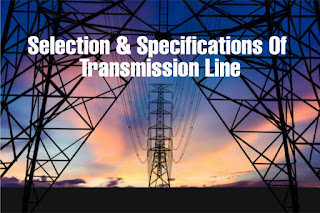Selection and Specifications Of Transmission Line
 |
| Selection and Specifications Of Transmission Line |
Following factors are affecting the selection and specifications of transmission lines:
- ✓ Size of transmission conductors
- ✓ Spacing and distance between conductors
- ✓ Insulator types
- ✓ Insulation co-ordination
- ✓ Voltage regulation
- ✓ Power losses
- ✓ Voltage level of transmission line
- ✓ Tower designs
- ✓ Clearance levels
- ✓ Noise emission
- ✓ Corona loss
- ✓ Weather conditions e.g. temperature, wind etc.
- ✓ Mechanical strength of selected conductors
- ✓ Air pollution
In high temperature regions, conductor material chosen for transmission line should have higher temperature coefficient of resistance. Wind load affects the sag clearance putting more pressure on transmission lines.
Mechanical strength of selected conductors should be higher to avoid breaking of conductor due to wind pressure or increase in temperature etc.
Moisturised air or polluted air causes chemical effects on transmission lines leading to damage. Towers are giving mechanical support to the transmission lines.
Useful Electrical Articles Must Read:
Non proper design of tower leads to failure or damage to the transmission lines. Voltage level decides the size of transmission line conductors used for transfer of power.
Insulators are needed to be proper size and rating. If it is not there it leads to flashover of and braking transmission line conductors.
Proper spacing and distance between conductors should be maintains other it leads to short circuit during operations or working.
Basic Insulation Level (BIL) should be maintained. Improper insulation co-ordination leads to failure of transmission lines in case of faults.
Larger power losses affect the efficiency and performance of transmission lines. So transmission line conductors should have low resistance.
More Related Articles:

This comment has been removed by the author.
ReplyDeleteWhy we need Banking System? and Talibilm provide all news related to study and you can also get info about latest results.
ReplyDeletepower cables are really needed for this project. Transmission lines should not be low quality
ReplyDelete